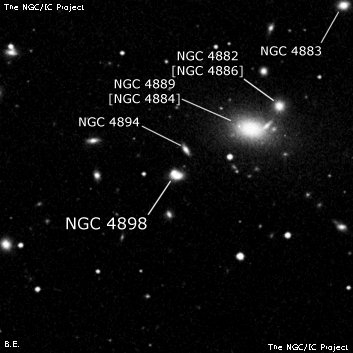
John Herschel likely discovered NGC 4898 = h1510 on 13 Apr 1831 and recorded "the last of 5, south of a * 7m; more suspected to the south." Since the 4th object in the sweep (h1507) refers to NGC 4889, and he reported the declination as 1' south, Harold Corwin concludes that h1510 (later NGC 4894) is likely the earliest observation of NGC 4898, and not fainter CGCG 160-247 just 1' NW. JH catalogued a second earlier observation of h1510 on 30 Mar 1827, but that refers to NGC 4889. Heinrich d'Arrest made three fairly accurate measurements of this galaxy and questioned if it was h1510.
Because of the density of galaxies in the Coma cluster, there was a great deal of confusion on the identities! Bigourdan and d'Arrest later measured an accurate position for NGC 4898 and both are credited in the NGC, so its identity is not in doubt.
300/350mm - 13.1" (5/14/83): faint, small, slightly elongated. Located 3' SE NGC 4889 in AGC 1656.
400/500mm - 17.5" (4/21/90): located in the central core of AGC 1656 cluster 2.5' SE of brightest member NGC 4889. Faint, very small, slightly elongated. This is the last of four on a line with NGC 4894 just 45" NW, NGC 4889 2.5' NW and NGC 4886 3.5' NW.
900/1200mm - 82" (5/5/19, McDonald Observatory): at 613x; very easily resolved into two components [centers separated by 7" SW-NE]. The brighter southwestern component appeared bright, fairly small, round, very bright nucleus. The northeastern component was moderately bright, small, round, slightly brighter nucleus. Both galaxies were encased in a common halo.
PGC 44741, just 1.1' S, was fairly faint, fairly small, elongated 2:1 (central bar), slightly brighter nucleus.
PGC 44732, just 0.8' NNW, was fairly bright, fairly small, elongated 5:2 SW-NE, 20"x8", brighter nucleus. This galaxy is misidentified as NGC 4898 in modern sources.
Notes by Steve Gottlieb